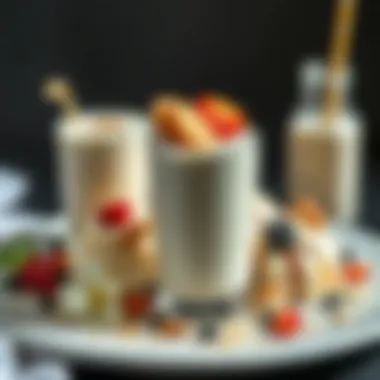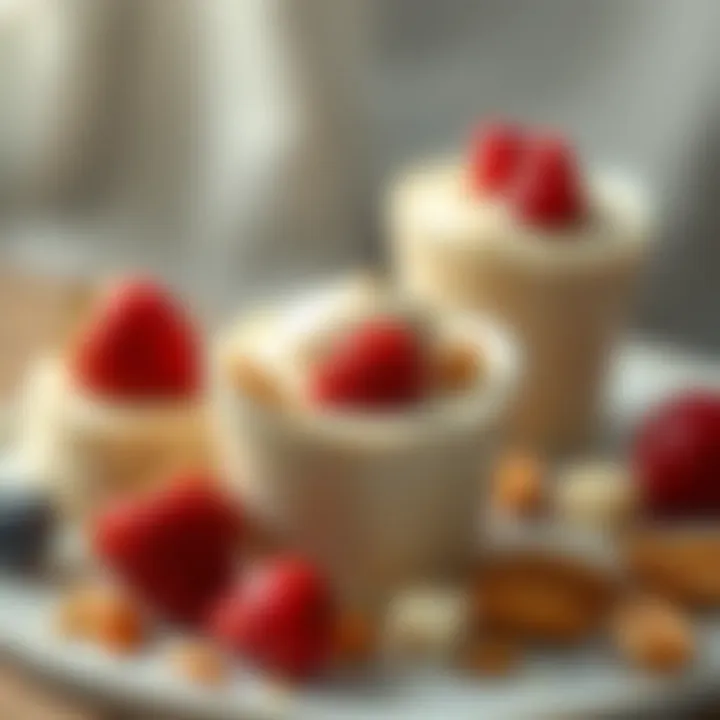Exploring the World of Milk Desserts: A Complete Guide


Intro
Milk desserts are more than just sweet treats; they embody a spectrum of culture, tradition, and innovation. Across the globe, diverse communities have crafted unique variations of milk-based confections that reflect their heritage and culinary creativity. This journey through the realm of milk desserts provides not only a feast for the palate but also an enriching exploration of history and craftsmanship.
Milk desserts hold a special place in many diets, offering both nutrition and indulgence. The creamy texture and delicate flavors of these confections have made them staples in numerous cuisines. From rich panna cotta in Italy to the velvety flans of Latin America, each dessert tells a story that goes far beyond its ingredients. This article will serve as a roadmap, steering through the captivating world of milk desserts, unpacking their origins, and revealing the methods that transform simple ingredients into extraordinary creations.
Historical Context of Milk Desserts
Understanding the historical context of milk desserts not only provides a glimpse into our culinary past, but it also highlights the significance of these treats in various cultures. From ancient traditions to modern innovations, the evolution of milk desserts reflects changes in society, agriculture, and technology. This section explores how these delicious creations emerged and transformed over time, serving both as indulgences and markers of cultural identity.
Ancient Origins
The roots of milk desserts stretch back to ancient civilizations, where dairy was first recognized for its nutritional value. In ancient Egypt, people created a sweetened milk mixture that resembled what we now call custard. Made from milk, honey, and grain, this early dessert showcased the significant agricultural advancements of the time.
Similarly, in Mesopotamia, the Sumerians were known to have prepared delightful milk-based treats. They used a combination of milk and sweeteners, perhaps figs or dates, indicating a sophisticated palate for sweet flavors. These early examples showcase how milk desserts were among the first processed foods, leading to a deeper appreciation of rich, sweet tastes that continue to captivate us today.
Culinary Evolution through Cultures
As trade routes opened and cultures collided, the methods and ingredients used in milk dessert production evolved markedly. In the Mediterranean, Greek and Roman influences led to the development of various custards and puddings, heavily flavored with local honey and nuts. The techniques learned from these ancient societies shaped dessert-making in Europe, introducing flavors and styles that would become staples in later cuisines.
Across the globe, Indian culinary practices demonstrated an artistry for milk desserts like Kheer, a rice pudding rich with spices. The rich history of desserts in India highlights how cultural exchanges across borders enhanced the diversity of milk-based sweets. Each region developed its own distinct flavors and preparation methods, resulting in an array of sweet delights that cater to local tastes.
"In every culture, the dessert tells a story of its origins, of the earth's bounty, and of people’s relationship with milk."
Traditional Recipes Across Regions
The beauty of milk desserts lies in their diverse interpretations around the world. Each region boasts traditional recipes that are often passed down through generations, rich in history and local flavor.
For instance, in France, the iconic Crème Brûlée exemplifies how a simple custard can be elevated to culinary art through technique. Meanwhile, in Italy, the velvety Panna Cotta represents a delightful take on sweetened cream, often flavored with fruits or nuts.
Looking to the Middle East, one might encounter the traditional dish of Muhallebi, a milk pudding infused with rosewater or orange blossom. These variations reflect not only regional tastes but also the historical context of available ingredients and cultural significance.
Nutritional Aspects of Milk Desserts
Understanding the nutritional aspects of milk desserts is crucial for anyone looking to appreciate both their delightful taste and their health profiles. These desserts, often rich and creamy, can be more than just indulgent treats; they can also offer significant benefits when prepared thoughtfully. This section dives into the macronutrients found in milk-based sweets, their health benefits, and the alternatives available for people with varying dietary preferences.
Macronutrients in Milk-based Sweets
Milk desserts are typically composed of three main macronutrients: carbohydrates, proteins, and fats. Each plays a vital role in both the flavor and nutritional profile of these delightful confections.
- Carbohydrates: These provide sweetness and energy. Sugars from milk, like lactose, naturally sweeten desserts, while additional sugars added during preparation can enhance flavor.
- Proteins: Proteins from milk help in building and repairing tissues, and they improve the texture of desserts, making them smooth and creamy. Casein and whey are the primary proteins in milk, contributing to both flavor and fullness.
- Fats: Dairy products often contain fats that give the dessert a rich mouthfeel. The fats in milk desserts not only enhance taste but also aid in the absorption of fat-soluble vitamins, making them more nutritious.
Exploring the balance among these macronutrients can lead to a more understanding how to craft or enjoy milk desserts that cater to both taste and health.
Health Benefits of Dairy Ingredients
The inclusion of dairy in desserts brings along numerous potential health benefits. Some of these are backed by scientific studies, while others stem from traditional wisdom. Here are some key benefits:
- Calcium and Vitamin D: Dairy is a significant source of calcium, essential for bone health. The Vitamin D found in fortified milk helps in calcium absorption.
- Probiotics: Certain dairy desserts, like yogurt-based sweets, may contain probiotics which promote gut health. These beneficial bacteria support digestion and improve overall well-being.
- Satiety: The protein and fat combination found in milk desserts can lead to greater feelings of fullness, making them a rewarding treat that can help curb snack cravings later on.
"Milk desserts not only satisfy the sweet tooth but can also serve as a nourishing choice when made with wholesome ingredients."
Alternatives for Dietary Preferences
In today’s diverse culinary world, many individuals pursue specific diets for health, ethical, or personal reasons. Thankfully, there are numerous alternatives for creating delicious milk desserts that cater to various dietary restrictions or preferences:
- Non-dairy milks: Options like almond, soy, coconut, and oat milk can easily replace traditional dairy in recipes. Each has its own unique flavor profile and can add interesting dimensions to desserts.
- Sugar substitutes: For those watching their sugar intake, sweeteners such as stevia, agave nectar, or monk fruit can be incorporated without sacrificing sweetness.
- Gluten-free options: Using alternative flours like almond flour or coconut flour can help those with gluten sensitivities enjoy milk desserts without worry.
By understanding these alternatives, one can craft delightful recipes that respect different dietary needs without compromising on taste.
Fundamental Techniques in Milk Dessert Preparation
Mastering the art of milk dessert preparation involves understanding a few core techniques that can significantly enhance the quality of your creations. Each approach not only serves a functional purpose but also elevates the dessert from a simple sweet treat to a culinary masterpiece. When you dive into the realm of milk-based desserts, knowing your way around these techniques can make all the difference between a runny custard and a perfectly set flan. Let's unpack these fundamental elements that every chef, whether aspiring or seasoned, should grasp.
Basic Cooking Methods
Cooking methods form the backbone of any dessert preparation, and milk desserts are no exception. Familiarity with various techniques can help you achieve silky textures and rich flavors. Here’s a look at some essential methods:
- Simmering: Often applied in making sauces and puddings, a gentle simmer helps to dissolve solids while preventing curdling. It’s important to keep the heat low and stir regularly.
- Baking: This method is crucial for custards and some traditional puddings. Baking in a water bath prevents overheating and promotes even cooking. A well-baked custard should quiver slightly when shaken.
- Chilling: Many milk desserts require chilling to set properly, especially gelatins and some mousses. Understanding the proper cooling times is key; rushing this step can lead to runny desserts.
Each of these methods, when used correctly, can enhance not just the taste but also the presentation of your desserts.
Emulsification and Texturing


Two terms that often come up in the world of milk desserts are emulsification and texturing. These processes are essential for developing the right consistency and mouthfeel.
Emulsification is the technique of combining two normally unmixable liquids, such as oil and water. For milk desserts, achieving a stable emulsion can help retain airiness which contributes to a light and creamy texture, especially in recipes like ice creams and whipped creams. Techniques include:
- Whisking: Incorporating air during whisking creates a light and fluffy texture in whipped cream or meringues.
- Blending: This is helpful when making sauces like crème Anglaise; a powerful blender can create a smooth emulsion, ideal for pouring over desserts.
Texturing, on the other hand, is about manipulating the consistency of the dessert—making it smooth, crunchy, or velvety. For example, folding in beaten egg whites into a batter ensures a light texture, while incorporating chocolate into a custard creates richness.
Thickening Agents and Their Uses
Thickening agents play a pivotal role in milk desserts, giving them the desired body and consistency. Several options are available, each with its unique characteristics:
- Cornstarch: This is a common thickener for puddings and sauces, providing a glossy finish once cooked through. Always mix it with cold liquid before adding it to heated mixtures to avoid lumps.
- Gelatin: Widely used for creating jellies and certain mousses, gelatin gives a firm texture that melts in your mouth. For a vegetarian alternative, agar-agar can be used.
- Eggs: Particularly egg yolks, are wonderful natural thickeners; they not only contribute to flavor but also stabilize custards when heated gently.
Knowing which thickening agent to use can profoundly impact the final dessert's taste and texture. Each has specific applications that can influence the outcome, so taking the time to learn about them is well worth the effort.
Diverse Milk Dessert Recipes
When it comes to milk desserts, diversity is the spice of culinary life. Each recipe tells a story, reflecting the cultural nuances and historical traditions of the regions they hail from. Within this section, we explore a range of unique milk-based desserts, each possessing its own character and charm. This multitude of options allows not just for indulgence but also for a deeper appreciation of the rich history and techniques involved. Embracing diversity in milk desserts means crafting experiences that resonate with a vast audience, be it a holiday gathering or a casual weeknight treat.
Custards and Puddings
Custards and puddings form the backbone of many milk dessert recipes, revered across continents. The creamy texture and luxurious feel of a perfectly made custard is unmatched. Traditionally, custards are based on a simple combination of milk, sugar, and eggs; this flexibility allows for various flavor additions. You might find vanilla, chocolate, or seasonal fruits incorporated for an added kick.
Benefits of custards include:
- Versatility: Custards can be served warm or cold, fitting various occasions and preferences.
- Ease of Preparation: They often require minimal ingredients and can be prepared ahead of time, making them perfect for entertaining.
- Nutritional Value: With the protein from eggs and calcium from milk, custards provide valuable nutrients.
However, precision is crucial. Overheating can lead to curdling, ruining the creamy experience. Careful attention to temperature and timing can make the world of difference.
Ice Cream and Gelato Variants
Ice cream and gelato have become iconic staples in dessert culture. While both use milk, the nuances in ingredients and technique set them apart. Ice cream is typically richer due to a higher fat content, while gelato uses more milk and less cream, resulting in a denser texture.
Common flavors you might encounter include:
- Classic vanilla
- Chocolate fudge brownie
- Exotic flavors like lavender or matcha
Creating these frozen delights can be both a scientific and artistic process. Temperature control, churning speed, and ingredient quality all influence the final product. With the rise of artisanal ice cream makers, there is a delightful push towards inventive flavors and locally-sourced ingredients that reflect seasonal changes, inviting a unique taste experience with every scoop.
Traditional Indian Sweets
India's rich culinary heritage boasts an array of milk-based sweets that are both intriguing and delectable. From kulfi, a densely creamy frozen dessert, to kheer, a rice pudding flavored with cardamom and garnished with nuts, these treats highlight the versatility of milk in creating satisfying desserts.
Each region of India showcases its unique offerings; for example, rasgulla from Bengal and mithai from Maharashtra share a common base of milk but differ widely in preparation and taste. Engaging with these sweets often means participating in cultural festivals, where sweets have a symbolic place during celebrations. Understanding the role of these desserts in Indian culture gives a deeper appreciation for their flavors and textures.
Asian Milk Desserts
Across Asia, milk desserts have varied influences reflecting local ingredients and tastes. From the popular mango sticky rice in Thailand to ada pradhaman, a coconut milk dessert from Kerala, these options further enrich the landscape of milk desserts.
Some notable mentions include:
- Taho - Soft silken tofu topped with syrupy sweetened water and sago pearls, a favorite breakfast treat in the Philippines.
- Bubur Ketan Hitam - A comforting black glutinous rice pudding made with coconut milk, found in Indonesia.
This variety offers not only a sensory experience but also showcases the creativity embedded in Asian culinary traditions.
Chocolate and Caramel Infusions
Lastly, the allure of chocolate and caramel in milk desserts cannot be understated. When combined, they create a harmonious blend that captivates the palate. Chocolate puddings, custards, and sauces enhance the richness that milk brings, elevating desserts to new heights. The infusion of caramel adds a complex sweetness that many find irresistible.
Popular variations include:
- Chocolate mousse, light and airy, or
- Caramel flan, which balances creamy textures with the deep sweetness of caramel.
Incorporating quality chocolate and artisanal caramel can transform everyday desserts into elegantly sophisticated options, making them suitable for both casual and formal occasions.
Modern Adaptations of Milk Desserts
In today's culinary landscape, the realm of milk desserts is experiencing a renaissance that reflects changing tastes and global influences. This section aims to explore contemporary adaptations while being anchored in tradition. Understanding these modern takes on dairy-confectionery not only highlights the versatility of milk as an ingredient but also fosters a deeper appreciation for cultural experimentation and innovation.
Modern adaptations bring forth a wealth of flavors and textures that break away from conventional boundaries. It invites chefs and home cooks alike to interpret classic recipes through fresh perspectives. As more people become creative in their dessert-making, we see a fusion of cuisines that leads to a delightful uncovering of milk dessert variations.
Fusion Cuisine Trends


Fusion cuisine is at the heart of modern adaptations, standing as a vibrant example of how culinary traditions can intermingle. Here, chefs combine elements from various cultural backgrounds to create something utterly unique. Take, for instance, a Japanese matcha panna cotta. This dessert melds the Italian classic with savory Japanese green tea, resulting in a fresh take that captivates the senses.
A few notable trends include:
- Miso Caramel Flan: The saltiness of miso enhances the richness of the flan, creating a depth of flavor that surprises.
- Chai Spiced Rice Pudding: Incorporating traditional Indian chai spices lends a warm and aromatic profile to a simple dessert, evoking memories and comfort.
- Tropical Fusion Gelato: Combining flavors like coconut and passion fruit, this gelato reflects influences from both Italian gelato-making and Southeast Asian flavors.
"The beauty of fusion desserts lies in their ability to tell stories, weaving a narrative through each bite that celebrates culture and creativity."
The world of fusion desserts offers endless opportunities for experimentation. It's not merely about mixing two cuisines but about honoring every contributing culture's identity.
Vegan Alternatives and Innovations
As dietary preferences evolve, there's a significant shift towards plant-based options in milk desserts. This movement is propelled by a growing awareness of health and environmental implications. Vegan alternatives do not compromise on taste or texture, proving that one can enjoy rich desserts without dairy.
Innovations include:
- Coconut Yogurt Panna Cotta: Made with coconut milk, this version remains creamy while being dairy-free.
- Cashew Cream-Based Cheesecakes: Cashews blended with plant milk create a rich texture, mimicking traditional cheesecakes.
- Almond Milk Chocolate Mousse: A simple yet decadent treat that utilizes almond milk to achieve a silky smooth dessert.
These creative alternatives not only cater to those avoiding dairy but also introduce a broader audience to new flavors and innovations.
Gastronomy and Milk-based Techniques
Gastronomy looks beyond just the recipe—it embraces the science behind flavors, textures, and presentation. Techniques such as spherification and sous-vide have found their place in milk dessert creation, making them not just delectable but also visually stunning.
For example:
- Spherification: This technique involves creating caviar-like pearls of flavored milk or yogurt that can burst with flavor when bitten into. It changes the texture and presentation dramatically.
- Sous-vide Cooking: Slow-cooking custards at low temperatures ensures a delicate and consistent texture, eliminating the risk of curdling that traditional methods face.
- Whipping Techniques: Understanding how to whip creams to their peak can transform a simple dessert into a light and airy experience.
Utilizing these techniques not only enhances the final product but also showcases a commitment to the craft of dessert-making, blurring the lines between culinary art and science.
Pairing Milk Desserts with Beverages
Pairing milk desserts with beverages can significantly enhance the dessert experience. The right beverage not only complements the flavors of the sweet but also balances the richness that comes with milk-based ingredients. This section explores various beverage options that harmonize beautifully with milk desserts. Understanding these pairings can elevate a simple dessert to a gastronomic delight. From the robust notes of coffee to the lightness of tea, the right drink can accentuate the flavors while providing a refreshing contrast.
Coffee and Tea Combinations
Coffee has long been a companion to desserts, and its deep, invigorating flavor is a perfect counterpoint to the creamy sweetness of milk desserts. A classic pairing is vanilla custard with a shot of espresso. The bitterness of the coffee cuts through the custard's richness, creating a balanced bite.
Similarly, different teas can offer soothing relief that complements milk-based treats. For instance, pairing green tea with matcha panna cotta introduces a fresh, earthy note that enhances the dessert's elegance. Other options include:
- Chai Tea: With its spices, it beautifully melds with decadent milk-based sweets.
- Earl Grey: Provides a floral hint, perfect with lemon-infused desserts.
- Chinese Oolong: The nutty undertones work well with creamy desserts like milk tart or flan.
In many cultures, having a cup of tea with dessert is quite common, and for good reason. The combination can transform a moment of indulgence into a ritual.
Wine and Dessert Pairings
While coffee and tea often spring to mind, wine can be an overlooked yet exquisite choice when paired with milk desserts. The trick is to match the wine’s sweetness and acidity with the dessert’s creamy texture. For example, a rich caramel flan pairs well with a glass of Pedro Ximénez sherry, which echoes the dessert's caramel notes while adding a fruity contrast.
Here are a few notable combinations:
- Sweet Riesling: Complements panna cotta, enhancing the vanilla flavor.
- Moscato: Its lightness balances heavier milk desserts like cheesecake or tiramisu.
- Prosecco: A sparkling option, it adds a pleasant effervescence that can lighten the experience alongside rich ice creams.
"A thoughtful pairing brings out layers of flavor that might otherwise go unnoticed. The marriage of wine and milk dessert can be a match made in culinary heaven."
The Role of Presentation in Milk Desserts
Presentation plays a pivotal role in the appreciation of milk desserts, which are not just a feast for the palate but also a visual delight. The experience of consuming these sweets extends beyond flavor—seeing a well-crafted dessert can provoke excitement, anticipation, and an emotional connection to the culinary art. When desserts are presented beautifully, they not only capture the eye but also elevate the overall dining experience. It reflects the effort and thought put into making the dessert and can show respect for both the ingredients and the diner.
A well-presented milk dessert can enhance its perceived taste and quality. Consider how a simple vanilla pudding can morph into a stunning creation with the right plating and garnishes. The act of presenting food is often the first interaction a diner has with it, sparking curiosity and giving an immediate impression of quality.
Here are some key elements of presentation to consider:
- Color Contrast: Using contrasting colors can make the dish visually appealing. For example, a creamy white panna cotta garnished with vibrant raspberry coulis creates a striking contrast.
- Height and Structure: Layering components or stacking ingredients can add dimension to a dessert. A milkshake piled high with whipped cream and chocolate shavings not only looks indulgent but also announces its flavor boldly.
- Serving Vessels: The choice of glass or dish matters. For instance, a classic dessert served in a decorative bowl can add to its charm and entice diners.
These elements of presentation are essential in capturing attention and enhancing appreciation, particularly in an age where social media often defines what is considered trendy or exceptional. A beautiful image of a milk dessert can compel others to try it, thus bridging the gap between appearance and taste.
Plating Techniques
When it comes to milk desserts, effective plating techniques are key for transforming simple creations into works of art. The goal is not merely to serve food, but to artfully create a presentation that complements the flavors and textures of the dessert.
Begin with the layout on the plate. Centering the dessert draws focus, while sweeping sauces across the plate can add dynamism to the presentation. A ring mold can be a handy tool for stacking components neatly. Consider layers; for instance, placing a mousse above a cookie base not only enhances taste but can also showcase beautiful layers visually.
Using bright sauces as accents can guide the eye and enhance the overall aesthetic. For instance, a caramel swirl placed skillfully around a crème brûlée invites diners to appreciate both the color and the rich flavor it promises. Finally, always assess the overall balance; an overloaded plate can detract from the dessert’s charm. Less can often be more.


Garnishes and Finishing Touches
The garnishes selected for milk desserts are the cherry on top—they can significantly affect both the flavor and the aesthetic appeal. A thoughtful garnish not only serves to enhance the visual presentation but also offers an additional layer of flavor or texture, making the experience more complex.
Consider using fresh herbs like mint or basil. They can add color and a refreshing taste that can brighten the overall dessert. Fruits, whether fresh or dried, can add a burst of color and serve as a reminder of the flavors within the dessert.
Here are some ideas for garnishes:
- Edible Flowers: Perfect for adding a touch of elegance, these can introduce color and a hint of unique flavor, allowing the dessert to stand out as truly special.
- Crunchy Textures: A sprinkle of toasted nuts or crushed cookies on top of a creamy dessert can create a delightful contrast, appealing to the bite and enhancing flavor.
- Chocolate Shavings: A classic touch, they can elevate a simple dessert, adding depth and richness to both appearance and taste.
Garnishes are not entirely frivolous; they should have a purpose. They can complement the primary flavors of the dessert and provide a sense of completion to the dish. Overall, the role of presentation — through both plating techniques and garnishes — is indispensable for truly honoring the art of milk desserts.
Exploring Cultural Significance of Milk Desserts
Milk desserts are not merely a treat for the palate; they serve as a vital cultural artifact across various societies. This section delves into how these delightful confections intertwine with traditions, festivals, and the very fabric of communal life. The cultural significance of milk desserts extends beyond their taste; they embody histories, stories, and rites that evoke nostalgia and belonging.
Celebrations and Festivities
From birthdays to religious ceremonies, milk desserts play a pivotal role in marking significant milestones. They often signify warmth and hospitality, serving as a sweet welcome to friends and family. For example, in many Middle Eastern cultures, Knafeh takes center stage during weddings, symbolizing wealth and prosperity. Similarly, during the Hindu festival of Diwali, sweets such as Gulab Jamun, made primarily from milk solids, are exchanged among family and neighbors as a gesture of goodwill.
These sweets are not only enjoyed but also serve as a medium for storytelling. Every recipe carries an anecdote, often passed down through generations, weaving together personal and communal histories. While celebrating birthdays, for instance, many families uphold the tradition of baking a Milky Way cake to highlight the sweetness of the journey so far.
"Food is not just fuel; it’s an expression of our identities. Milk desserts are rich in history and reveal so much about us."
Celebrations, therefore, are more enriched with the inclusion of milk desserts, as they bring together arts, culture, and culinary practices. In this way, they transcend simple enjoyment and become central to cultural expression.
Regional Variants and Their Stories
Diverse cultures have their unique takes on milk desserts, each resonating with local flavors and seasonal offerings. For instance, Panna Cotta from Italy showcases a delicate balance between creaminess and sweetness, typically garnished with seasonal fruits. In contrast, the Thai Mango Sticky Rice combines coconut milk with glutinous rice, highlighting the tropical essence of Southeast Asia. Each dessert tells a story that reflects the geography and heritage of its origin.
In Mexico, the flan, a caramel custard dessert, is often associated with family gatherings, with each family claiming a special recipe. These regional variants not only highlight differing ingredients but also reveal local preferences and agricultural practices. Furthermore, these desserts carry cultural narratives; for example, the prominence of dairy in Western nations underscores their agricultural priorities and lifestyle choices.
The intimate connection between milk desserts and the cultures they belong to emphasizes the role of food in human experience, demonstrating how ingredients can tell tales of triumphs, challenges, and the day-to-day lives of people.
In sum, the cultural significance of milk desserts encapsulates both timeless recipes and stories of communal experiences, making them an essential component in the fabric of society. From hearty celebrations to the intimate sharing of familial recipes, milk desserts foster connections across generations and geographies.
Challenges in Crafting Milk Desserts
Crafting milk desserts may seem like a straightforward process, but it is fraught with challenges that can thwart even the most experienced chefs. The process requires a delicate balance of ingredients, temperatures, and times. Understanding these challenges is crucial, as they can significantly impact both flavor and texture, leaving one dissatisfied with the results.
Mistakes can range from the mundane to the complex. For instance, undercooking or overcooking can turn a luscious custard into a rubbery mess. Likewise, the quality of ingredients, particularly dairy, plays a pivotal role in the final product. With proper attention to detail, these pitfalls can be avoided, leading to a successful dessert.
Common Mistakes and How to Avoid Them
One of the most frequent errors in creating milk desserts is improper temperature control. When heated too quickly, proteins in the milk can curdle. To prevent this, always opt for low and slow when heating your milk. Use a thermometer if you're unsure about your stovetop's heat, aiming for a steady simmer rather than a rolling boil.
Another common mistake involves mixing ingredients prematurely. For example, combining sugar into milk before it’s at the right temperature can lead to uneven sweetness and texture. It's better to allow the milk to warm first and then sweeten it gradually.
Lastly, neglecting the recipe's recommended resting or chilling times can result in desserts that don't gel properly or have the intended creaminess. Patience is key when allowing a panna cotta or custard to set, so do not skip this important step.
"Patience is the name of the game in dessert making. A fine dessert is often a labor of love, not a race."
Ingredient Quality and Sourcing
The the ingredients you choose can make or break your milk dessert. Fresh, high-quality milk is essential, as it directly affects flavor and creaminess. Business owners need to develop relationships with local dairy farms to ensure they are sourcing the best products. Look for organic options if possible. The taste difference is often perceptible.
When it comes to sugar, the granulated white stuff might seem standard, but experimenting with alternatives, like brown sugar or honey, can yield delightful new flavors. Be wary of using powdered sugar, however—while it may dissolve quickly, it sometimes leads to a grainy texture in your dessert.
In addition, consider the use of stabilizers or flavor enhancers. While they can be helpful, sourcing natural and organic options respects both your health and the integrity of your dessert. Always check where your ingredients come from; this not only promotes sustainability, but can also enhance the quality of your dishes in an artful way.
In lagging behind on these points, one risks not only the integrity of the dessert but also its reputation.
Learn more about milk quality at this link: Food and Nutrition
Browse ingredient sourcing options on websites like: LocalHarvest
Epilogue
As we draw the curtains on this rich exploration into the realm of milk desserts, it becomes clear that these delightful creations are not mere treats but rather a tapestry woven with history, nutrition, and creativity. This article has illuminated the significance of milk desserts not only as a source of pleasure and indulgence but also as an intersection of diverse cultures and culinary techniques.
Reflecting on the Journey of Milk Desserts
The journey of milk desserts stretches back to ancient civilizations where the simple act of curdling and sweetening milk marked the genesis of what we now cherish. Each bite is a story of time, reflecting traditions handed down from generation to generation. Traditional recipes like rice pudding or panna cotta hold significance beyond taste; they connect us to our roots and cultural heritage. Embracing this narrative lends perspective to our modern adaptations. Recognizing these connections enriches our appreciation for simple ingredients turned into profound culinary experiences.
The versatility of milk desserts also deserves mention. With evolving tastes and dietary needs, contemporary dessert makers leverage the historical foundations while infusing innovative flair. The fusion of flavors and unexpected ingredient pairings are emerging trends that maintain the essence of milk desserts while catering to a broader audience, thus encouraging culinary exploration.
Invitation to Explore Further
Thus, we extend an invitation to all culinary enthusiasts, be they novices or seasoned chefs, to delve deeper into this enchanting world. The recipes and techniques outlined throughout the article are stepping stones on a larger journey of discovery. It is not only about crafting that perfect crème brûlée or a velvety panna cotta but about understanding the intricate dance of flavors, textures, and nutritional benefits.
To continue this exploration, consider engaging with local cooking classes or online workshops that focus on the artistry of milk dessert preparation. Resources like Wikipedia for historical context or forums like Reddit can offer community and support.
Additionally, we encourage experimentation. Don’t shy away from substituting traditional dairy with innovative alternatives or trying out new flavor combinations. Creating your own bespoke milk desserts can be as rewarding as enjoying a well-oiled recipe from a century ago. This journey of exploration promises not just culinary rewards but also a deepened understanding of our common heritage through the lens of milk desserts.



